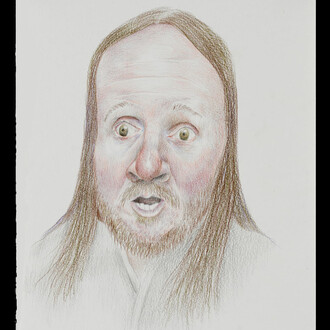Between my finger and my thumb
The squat pen rests.
Digging: Excavation, breaking or cutting off the surface.
As with the quote from Irish poet Seamus Heaney, a writer digs with their pen, and artists with their tools.
David Nolan Gallery is pleased to present a group show of artists who have exhibited at the gallery over the years. Through comparisons, the exhibition will encourage new visual and intellectual readings. The approach of creating trans-generational, cross-cultural, and multimedia juxtapositions has been the gallery’s underlying backbone for over thirty years.
The ultra-individualistic performance artist, energetic writer, and important painter Jonathan Meese (German, b. 1970) creates works that frequently include wordplays but his motivation, like Jörg Immendorff (German, 1945-2007), is the artists role in society. As with their predecessor Georg Grosz (German, 1893-1959), who was also a social critic, both Meese and Immendorff’s work drew from the belief that society without art is impossible to imagine. The painting included here is by Immendorff from his famous Café Deutschland series that began in 1977 and through the 80s and on. His friendship with A.R. Penck (German, 1939-2017), who lived on the other side of the Berlin Wall, became an example of the futility of borders and despot regimes that discouraged free speech and superficially divided a nation and its citizens by a wall which Immendorff came to use as a symbol of futility. Dieter Roth (German 1930-1998) believed in the courage of the artists and art and as a maverick, musician, poet, and artist. His attitude as a multi-media artist with worldwide influence spanning generations is also close to Meese in attitude and depth.
The movement and visual rhythms in Jorinde Voigt’s (German, b. 1977) diagrammatic work stems from her history as a musician. In her newest works, she begins with a sheet of paper, draws on it, then slices, cuts, and repositions it in multiple layers that become ripples of water dancing in the sea, full of movement. Voigt’s collage is installed beside Barry Le Va’s (American, 1941-2021) complex architectural installations and arrangements, which were created through a process of readjusting collage elements, much like a jazz musician searching for the right sound. With Mel Kendrick (American, b. 1949), the artist begins with a block of wood and the process of deconstruction and reconstruction in turn becomes the content. The sculptures are unplanned; no sketches or drawings are made in advance. The cutting and stacking of the forms in executed in real time. The investigations in assembling the elements embody time as an important element, and the artist insists that he must be surprised by the finished product each time.
David Hartt’s (Canadian, b. 1967) luscious platinum print, Olimpia, is a still from his film that features cellist Tomeka Reid at Philip Johnson’s Glass House in Connecticut. This portrait of Tomeka, who wears a bronze helmet reminiscent of Brancusi and evokes Les Contes d’Hoffmann, in the context of the Glass House shows us once more how Hartt’s research-based work builds narratives on top of existing histories to renegotiate and reinvent the boundaries of historical perspective.
Ian Hamilton Finlay’s (Scottish, 1925-2006) 1998 carved stone piece reverberates throughout the gallery with its text “Only Connect”, alluding to E.M. Forster’s book Howard’s End. Only through connecting can we live a purposeful life of intentional thought and genuine feeling. Finlay was a poet, philosopher, sculptor, and gardener who created one of the wonders of the world outside Edinburgh: Little Sparta, Finlay’s lifelong artwork (1966-2006) in the form of a cultivated 6-acre magical garden with pathways and streams meandering through the hilled landscape, interspersed with poetic texts on branches, plaques, and sculptures alluding to ancient and contemporary culture that open the mind to magnificent visions.
The exhibition will also present two Brazilian artists whose work is rarely seen in North America. Both artists work with color, texture, and volume, but their media differs. Norberto Nicola (Brazilian, 1931-2007) subverted the flat form of tapestry work by twisting and braiding thread, wool, and mane in multidimensional compositions that suggest a background of geometry. The organic form of Nicola’s work is placed in conversation with Paulo Pasta’s (Brazilian, b. 1949) distinctly vivid palettes and precise lines. Pasta’s paintings are representations of imagined spaces, where parallel, perpendicular, or diagonal lines suggest a contemplative and metaphysical architecture.
















